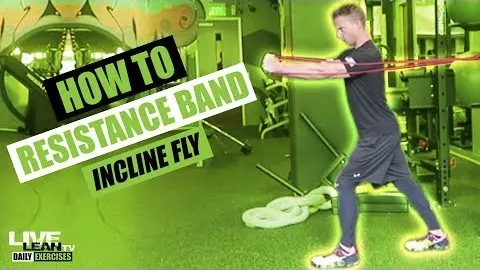
Are you looking to target and strengthen your chest, shoulders, and arms? The standing resistance band incline fly is a highly effective exercise that can help you achieve your goals. This exercise utilizes resistance bands, providing constant tension to your muscles throughout the movement, resulting in increased muscle activation and growth. In addition to building strength in your upper body, the standing resistance band incline fly also improves overall stability and balance. Read on to learn how to perform this exercise correctly and safely.
The standing resistance band incline fly is a variation of the traditional incline fly exercise. Instead of using dumbbells or a chest press machine, this exercise employs resistance bands to provide resistance. By standing and adjusting the angle of your body, you can target different areas of your chest muscles, shoulders, and arms.
To perform the standing resistance band incline fly, you will need the following equipment:
Here is a step-by-step guide to performing the exercise correctly:
Start by attaching the resistance band to a secure anchor point at chest height. Make sure the band is securely fastened and will not come loose during the exercise.
Stand facing away from the anchor point, with your feet shoulder-width apart. Hold one handle of the resistance band in each hand. Take a step forward, away from the anchor point, to create tension in the band. Your arms should be extended, and the band should be taut.
To target different areas of your chest muscles, adjust the incline by leaning your upper body forward or backward. For example, leaning forward will engage your upper chest, while leaning backward will target your lower chest. Start with a slight incline and adjust as needed to achieve the desired level of difficulty.
With the resistance band taut and your chosen incline, begin the exercise by slowly bringing your arms out to the sides. Maintain a slight bend in your elbows throughout the movement. Imagine hugging a tree as you bring your arms forward, squeezing your chest muscles. Exhale as you perform this concentric phase of the exercise.
After reaching the maximum point of the fly, slowly reverse the movement by bringing your arms back to the starting position. Inhale during this eccentric phase of the exercise.
Perform the exercise for the desired number of repetitions and sets, ensuring proper form and control throughout. It's important to listen to your body and increase or decrease resistance and incline as needed to maintain the right level of challenge.
To get the most out of your standing resistance band incline fly exercise and stay safe, keep the following tips in mind:
Warm up: Before starting any exercise, including the standing resistance band incline fly, warm up your muscles with dynamic stretches or a light cardiovascular activity. This will help prepare your body for the workout.
Use proper form: Focus on maintaining proper form throughout the exercise. Keep your core engaged, shoulders relaxed, and elbows slightly bent. Avoid using excessive momentum or swinging your arms.
Adjust resistance and incline: Start with a resistance band tension that challenges you, but allows you to complete the exercise with good form. As your strength improves, increase the tension by using a stronger resistance band or adjusting the anchor point. Similarly, modify the incline to target specific areas of your chest, based on your goals.
Breathe correctly: Inhale during the eccentric phase (returning to starting position) and exhale during the concentric phase (performing the fly movement). This breathing pattern helps stabilize your core and maintain proper form.
Gradually increase difficulty: As you become more comfortable with the exercise, you can increase the challenge by using heavier resistance bands, adjusting the incline further, or performing more repetitions and sets.
The standing resistance band incline fly can be incorporated into your upper body or full-body workout routine. Consider performing this exercise two to three times per week, allowing at least 48 hours of rest between sessions to allow for adequate muscle recovery and growth.
Here's an example of how you could structure your workout incorporating the standing resistance band incline fly:
The standing resistance band incline fly is a valuable exercise for strengthening your upper body. By incorporating this exercise into your workout routine, you can target and develop your chest, shoulders, and arm muscles effectively. Remember to always prioritize proper form, gradually increase the difficulty, and listen to your body to avoid injury. With consistency and dedication, you can achieve your fitness goals and reap the benefits of a stronger upper body.
If you're looking for a gym, fitness club or yoga studio, you've come to the right place.
You can find information about gyms in your area. Browse catalog of gyms and find gyms with classes which are you looking for.
On gym page you can find simple information like address, phone or website. You can find list of available classes. You can check availability of personal training or small group classes. On place page you can also see information about open hours.
You can find gyms near you with amenities, courts, studios and equipments.
Use our map to find gym at your city or district.
In Gym Navigator you can find list of exercises with movies for many body parts.
You can browse exercises catalog and find exercises the best of you.
You can also find exercises grouped into workout plans, which you can use to improve you body. Each routine show you exercises one by one and give you possibility to count you progress and count down rest time.